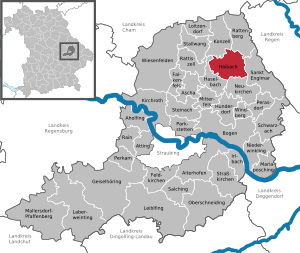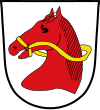Haibach (Lower Bavaria)
| coat of arms | Germany map | |
|---|---|---|

|
Coordinates: 49 ° 1 ' N , 12 ° 43' E |
|
| Basic data | ||
| State : | Bavaria | |
| Administrative region : | Lower Bavaria | |
| County : | Straubing arch | |
| Height : | 449 m above sea level NHN | |
| Area : | 32.37 km 2 | |
| Residents: | 2058 (Dec. 31, 2019) | |
| Population density : | 64 inhabitants per km 2 | |
| Postal code : | 94353 | |
| Primaries : | 09961, 09963, 09964, 09965 | |
| License plate : | SR , BOG, MAL | |
| Community key : | 09 2 78 129 | |
| Community structure: | 78 districts | |
| Address of the municipal administration: |
Schulstrasse 1 94353 Haibach |
|
| Website : | ||
| Mayor : | Fritz Schötz ( CSU ) | |
| Location of the municipality of Haibach in the Straubing-Bogen district | ||
Haibach is a municipality in the Lower Bavarian district of Straubing-Bogen .
geography
Geographical location
The place Haibach is 449 meters high in the Danube Forest region in a valley basin and is enclosed in the east by the Lanzlberg, Winterberg and Sommerberg , in the south the Hofberg rises with the Haibach ruins . The Schreinerbach flows through the place.
Community structure
There are 76 official parts of the municipality:
There are the districts Elisabethszell, Haibach, Irschenbach, Landasberg and Prünstfehlburg. Historic districts were Brell and Steinfurt .
history
Until the church is planted
Haibach, first mentioned in 1106, got its name from the knight dynasty of the Haybecken, later Haibeck. These were ministerials to the Counts of Bogen . In the memorial book of the Oberalteich monastery around 1100 a Wirnto von Haybach is mentioned, in 1320 Dietrich Haibeck and the abbot von Oberalteich are mentioned in a document when the cathedral in Regensburg was built. In 1494 the knight dynasty of the Hay basins at Haybach and Wiesenfelden went out. Their successors were the Notthaft in 1515 , later the Ossinger and the Leoprechtinger . The place was part of the Electorate of Bavaria and formed a closed Hofmark , whose seat was Haibach. In the course of the administrative reforms in Bavaria , today's municipality was created with the municipal edict of 1818 .
Incorporations
On January 1, 1971, Landasberg , Prünstfehlburg and parts of the former municipality of Irschenbach were incorporated. On January 1, 1978, the majority of the dissolved Elisabethszell community was added.
Population development
In the period from 1988 to 2018, the population stagnated or decreased minimally from 2,061 to 2,052 by 9 inhabitants or 0.4%.
- 1840: 228 inhabitants
- 1867: 469 inhabitants
- 1961: 2090 inhabitants
- 1970: 2120 inhabitants
- 1987: 2084 inhabitants
- 1991: 2093 inhabitants
- 1995: 2137 inhabitants
- 2000: 2162 inhabitants
- 2005: 2178 inhabitants
- 2010: 2137 inhabitants
- 2015: 2121 inhabitants
politics
The first mayor is Fritz Schötz (CSU).
Municipal council
The municipal council consists of the first mayor and 14 members, 7 of them from the CSU, 4 from the Free Voting Association and 3 from the ÜCW.
coat of arms
| Blazon : "In silver, a red horse's head with a gold bridle." | |
Attractions
- The Haibach castle ruins were the ancestral seat of the Haibecken and later the manor house, which came into rural possession in the 19th century and has since fallen into disrepair. The remains of the ruin were secured in 1986 by the newly founded association. In the middle of the courtyard, parts of the castle housing from the early 18th century have been preserved. The stable building has been used as a museum since 2005.
- The Catholic parish church of St. Laurentius has a Gothic tower and choir substructure, the nave was built in 1871. Inside there is a late Gothic Maria with child from around 1480.
Soil monuments
Economy and Infrastructure
traffic
The disused and dismantled former Straubing – Miltach railway ran through the community.
Economy including agriculture and forestry
In 1998, according to official statistics, there were no employees subject to social insurance contributions in the manufacturing industry 66 and in the trade and transport sector. In other economic areas, 73 people were employed at the place of work subject to social security contributions. There were a total of 691 employees at the place of residence subject to social security contributions. There was one company in the manufacturing sector and five companies in the construction sector. In addition, in 1999 there were 113 farms with an agriculturally used area of 1211 ha, of which 304 ha were arable land and 905 ha were permanent green space.
education
There are the following facilities:
- Day care center "Hofbergzwergerl": 50 kindergarten places and twelve day nursery places (as of 2014)
- Dietrich-von-Haibeck-Grundschule: 71 students with four full-time teachers (as of 2018/2019)
Personalities
Former Federal Minister and Vice President of the German Bundestag Gerda Hasselfeldt grew up in Haibach on her parents' farm with a butcher's and an inn. Her father Alois Rainer was a member of the Bundestag. Her younger brother Alois Georg Josef Rainer , long-time mayor of Haibach, was elected to the German Bundestag as a direct candidate for the constituency of Straubing-Regen in the 2013 federal election. He is the successor to Ernst Hinsken , also Haibacher.
Web links
Individual evidence
- ↑ "Data 2" sheet, Statistical Report A1200C 202041 Population of the municipalities, districts and administrative districts 1st quarter 2020 (population based on the 2011 census) ( help ).
- ^ Municipality of Haibach, list of official parts of the municipality / districts in the BayernPortal of the Bavarian State Ministry for Digital, accessed on August 5, 2020.
- ↑ District. Municipalities and districts. Bavarian Surveying Administration, archived from the original on April 11, 2013 ; accessed on March 31, 2015 .
- ^ Wilhelm Volkert (ed.): Handbook of Bavarian offices, communities and courts 1799–1980 . CH Beck, Munich 1983, ISBN 3-406-09669-7 , p. 437 .
- ^ Federal Statistical Office (ed.): Historical municipality directory for the Federal Republic of Germany. Name, border and key number changes in municipalities, counties and administrative districts from May 27, 1970 to December 31, 1982 . W. Kohlhammer GmbH, Stuttgart / Mainz 1983, ISBN 3-17-003263-1 , p. 632 .
- ↑ The Kingdom of Bavaria presented topographically and statistically in lexicographical and tabular form, Volume 1, page 119
- ^ Directory of the communities of the Kingdom of Bavaria according to the status of the population in December 1867: with ... In: Bayerische Landesbibliothek Online. 1869, pp. 52–53 , accessed January 2, 2015 .
- ↑ Mayor. Haibach community, accessed on August 12, 2020 .
- ↑ Municipal Council
- ↑ Entry on the coat of arms of Haibach (Lower Bavaria) in the database of the House of Bavarian History
- ↑ Crèche & Kindergarten. Haibach community, accessed on September 13, 2014 .
- ↑ Dietrich-von-Haibeck-Grundschule Haibach in the school database of the Bavarian State Ministry for Education and Culture , accessed on August 27, 2019.







